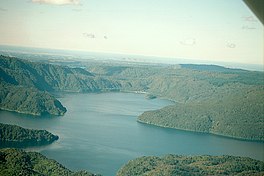geo.wikisort.org - Mountains
Lake Ōkataina (also spelled Okataina; Māori: Te Moana i kataina ā Te Rangitakaroro or Ōkataina) is the northernmost and largest of four smaller lakes lying between Lake Rotorua and Lake Tarawera in the Bay of Plenty region of New Zealand's North Island. The others are Lake Rotokakahi (Green Lake), Lake Tikitapu (Blue Lake), and Lake Ōkareka. All lie within the Ōkataina caldera, along its western edge.
This article needs additional citations for verification. (February 2009) |
| Lake Ōkataina | |
|---|---|
| Lake Okataina | |
 Aerial view from the south | |
 Lake Ōkataina | |
| Location | Bay of Plenty, North Island |
| Coordinates | 38°07′S 176°25′E |
| Type | crater lake |
| Native name | Te Moana i kataina ā Te Rangitakaroro (Māori) |
| Basin countries | New Zealand |
| Max. length | 6.2 km (3.9 mi)[1] |
| Max. width | 5.0 km (3.1 mi)[1] |
| Surface area | 10.8 km2 (4.2 sq mi)[1] |
| Average depth | 44.0 m (144.4 ft)[1] |
| Max. depth | 78.5 m (258 ft)[1] |
| Surface elevation | 311 m (1,020 ft)[1] |
| References | [1] |
Unlike many other lakes in the region, Lake Ōkataina is completely encircled by native forest. It also has no inlets or outlets. Perhaps as a result, over the past 30 years, the level of the lake has risen and fallen in a range of about 5 metres.
The New Zealand Ministry for Culture and Heritage gives a translation of "place of laughter" for Ōkataina.[2]
The lake can be accessed by road via Hinehopu on the southern shores of Lake Rotoiti. At the end of the road there is a large sandy beach, a massive grassed area and the privately owned Okataina Lodge. Due to changes in the surface level of the lake, the lodge jetty has at times been either completely submerged or left high and dry.
The area around the lodge is heavily populated by tammar wallabies introduced from Australia in the 19th century.[3]
References
- Lowe, D.J.; Green, J.D. (1987). Viner, A.B. (ed.). Inland waters of New Zealand. Wellington: DSIR Science Information Publishing Centre. pp. 471–474. ISBN 0-477-06799-9.
- "1000 Māori place names". New Zealand Ministry for Culture and Heritage. 6 August 2019.
- MacFarlane, Kristin (20 August 2006). "Where are the wallabies?". Rotorua Daily Post. Retrieved 7 September 2010.
External links
 Media related to Lake Okataina at Wikimedia Commons
Media related to Lake Okataina at Wikimedia Commons
На других языках
[de] Lake Ōkataina
Der Lake Ōkataina ist ein Kratersee im Rotorua District der Region Bay of Plenty auf der Nordinsel von Neuseeland.- [en] Lake Ōkataina
[fr] Lac Okataina
Le lac Okataina est un lac situé à Rotorua, sur l'Île du Nord de la Nouvelle-Zélande.[it] Lago Okataina
Il lago Okataina è il più grande e settentrionale della serie di laghi che giacciono fra il lago Rotorua ed il lago Tarawera nella regione di Bay of Plenty nell'Isola del Nord della Nuova Zelanda. Gli altri laghi del gruppo sono il lago Rotokakahi, lago Tikitapu ed il lago Okareka; tutti facente parte della caldera di Okataina. Il livello del lago si è alzato e abbassato di 5 metri a cavallo con l'inizio del XXI secolo.Другой контент может иметь иную лицензию. Перед использованием материалов сайта WikiSort.org внимательно изучите правила лицензирования конкретных элементов наполнения сайта.
WikiSort.org - проект по пересортировке и дополнению контента Википедии